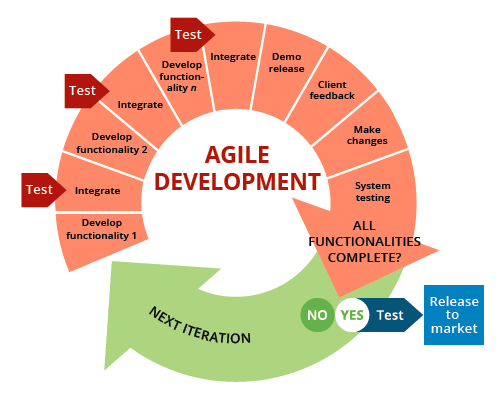Agile methodology has become a cornerstone in software development, known for its flexibility, efficiency, and focus on delivering high-quality products. Unlike traditional project management approaches, Agile emphasizes iterative progress, collaboration, and adaptability.
Benefits of Agile Methodology:
- Flexibility and Adaptability:
- Agile allows for changes and adjustments throughout the development process of the software projects. This flexibility ensures that the project can adapt to evolving requirements and market conditions.
- Improved Collaboration:
- Agile promotes collaboration among cross-functional teams. Regular meetings and open communication channels ensure that everyone is aligned and working towards common goals.
- Faster Time-to-Market:
- By breaking the project into smaller, manageable iterations, Agile enables faster delivery of functional product increments. This allows businesses to launch products quicker and gain a competitive edge.
- Higher Quality:
- Continuous testing and feedback loops are integral to Agile. This iterative testing ensures that issues are identified and resolved early, resulting in a higher-quality final product.
- Customer-Centric Approach:
- Agile focuses on delivering value to the customer. Regular feedback from stakeholders and end-users ensures that the product meets their needs and expectations.
Key Principles of Agile Methodology:
- Iterative Development:
- Agile projects are divided into small cycles called sprints. Each sprint focuses on developing a specific set of features, allowing for regular reassessment and adaptation.
- Collaboration and Communication:
- Agile promotes constant communication and collaboration among team members, stakeholders, and customers. Daily stand-up meetings and regular reviews keep everyone informed and engaged.
- Customer Involvement:
- Customers and stakeholders are actively involved throughout the development process. Their feedback is continuously integrated into the product, ensuring it meets their needs.
- Incremental Delivery:
- Agile emphasizes delivering functional product increments at the end of each sprint. This approach ensures that the project always provides value, even in its early stages.
- Continuous Improvement:
- Agile teams regularly reflect on their processes and outcomes to identify areas for improvement. Retrospectives are held at the end of each sprint to discuss what went well and what can be improved.
Implementing Agile in Software Projects:
- Start with Training:
- Educate your team on Agile principles and practices. Invest in training sessions and workshops to build a strong foundation.
- Choose the Right Tools:
- Use Agile project management tools like Jira, Trello, or Asana to facilitate collaboration and track progress.
- Define Roles and Responsibilities:
- Clearly define the roles of Scrum Master, Product Owner, and development team members. Ensure everyone understands their responsibilities.
- Establish a Roadmap:
- Create a product roadmap outlining the project’s vision, goals, and high-level features. This roadmap will guide the team’s efforts throughout the development process.
- Conduct Regular Meetings:
- Hold daily stand-up meetings, sprint planning sessions, and sprint reviews to keep the team aligned and focused.
By adopting Agile methodology, software development teams can enhance their productivity, deliver higher-quality products, and respond more effectively to changing requirements and market demands.

